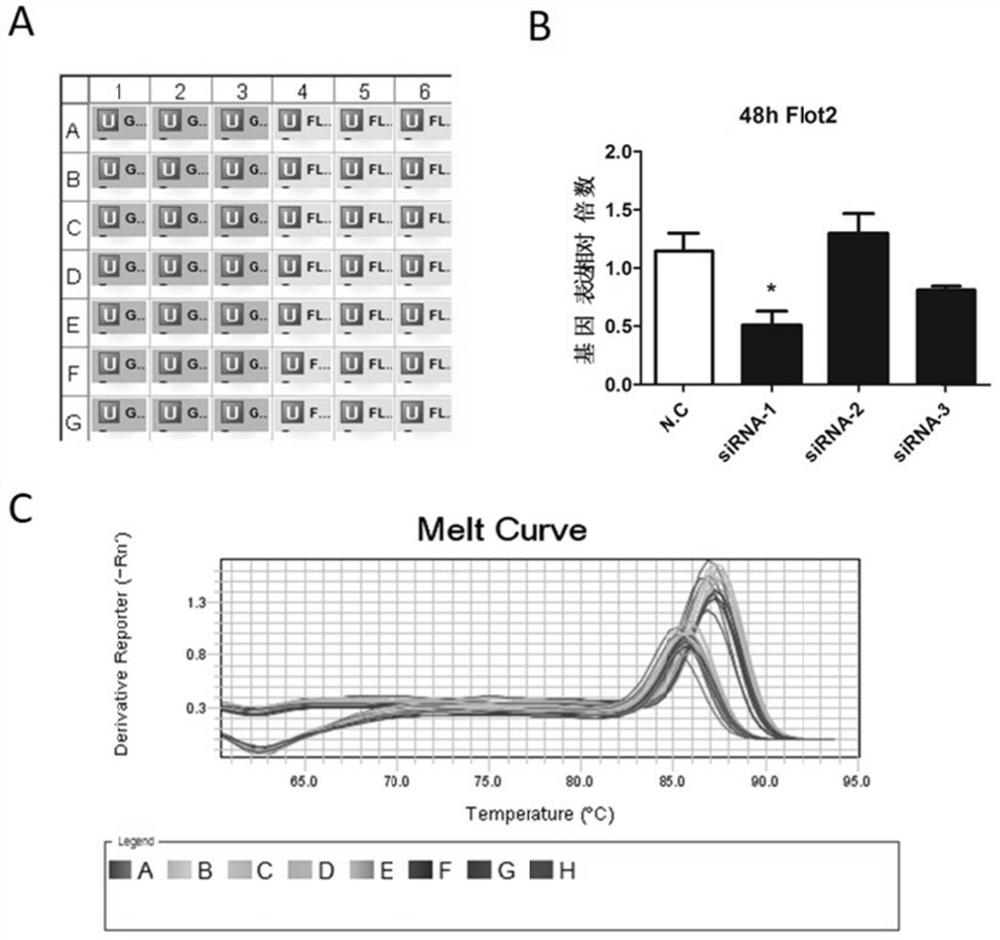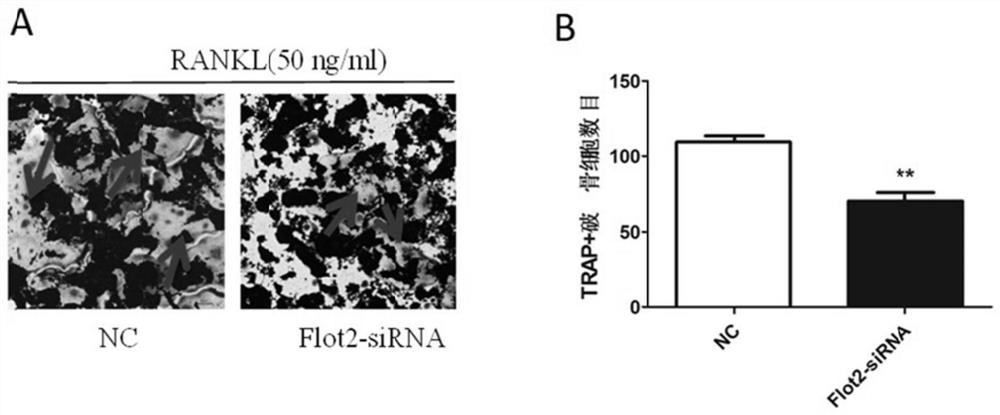Use of flot2 inhibitors to inhibit osteoclastogenesis and/or osteoclastic activity
A technology for inhibiting osteoclast and cell activity, applied in the field of biomedicine, and can solve the problem of unreported effects on bone cells
- Summary
- Abstract
- Description
- Claims
- Application Information
AI Technical Summary
Problems solved by technology
Method used
Image
Examples
Embodiment 1
[0037] Our previous studies found that the expression of Flot2 gene was significantly increased in RANKL, LPS, and tumor supernatant-activated osteoclast precursor cells. Therefore, it is speculated that the targeted inhibition of Flot2 gene expression may have the effect of inhibiting osteoclast formation. For the Flot2 gene, three specific siRNA sequences are involved, and the specific sequences are shown in Table 1, which were synthesized by Gemma Gene Company.
[0038] Table 1 RNA oligo sequence list
[0039]
[0040] 1. Cell culture:
[0041] Cell source: RAW264.7 mouse mononuclear macrophage leukemia cells were purchased from the Cell Bank of the Chinese Academy of Sciences.
[0042] Culture method: select RAW264.7 cells in good growth state and press 2×10 4 / well density seeded in a 24-well plate, at 37 ° C, 5% CO 2 Incubator incubation.
[0043] 2. Cell transfection:
[0044] After the cells were stably cultured for 4-6 hours, press Instructions for RNAiMAX T...
Embodiment 2
[0077] Example 2 Effect of Flot2-siRNA on Inducing Osteoclast Precursor Cells to Differentiate into Osteoclasts
[0078] Select RAW264.7 cells in good growth state and press 2×10 4 / well density seeded in a 24-well plate, at 37 ° C, 5% CO 2 Incubator incubation. After the cells were stably cultured for 4-6 hours, press Instructions for RNAiMAX TransfectionReagent Add the first siRNA (-260) Flot2-siRNA (Gimma gene) and the control NC-siRNA (Gemma gene) with the highest knockout efficiency obtained through screening to the cells, transfect for 24 hours, and then add RANKL ( The final concentration is 50ng / ml), TRAP staining was carried out on the 4th to 5th day of induction, observation was taken under a microscope, and osteoclasts were counted as TRAP-positive cells with more than 3 nuclei.
[0079] The result is as image 3 As shown, it can be seen from the results that Flot2-siRNA can significantly inhibit the formation of TRAP-positive osteoclasts in RAW264.7 cells induc...
Embodiment 3
[0080] Example 3 Effect of Flot2-siRNA on osteoclast activity of induced osteoclasts
[0081] Inoculate RAW264.7 cells on the artificial bone-coated Osteo Assay was cultured in 96-well plates, and the cells were washed away on the 7th day of induction, and photographed under a 40×Nikon inverted optical microscope. The results are as follows: Figure 4 As shown in A, the percentage of bone resorption area in each hole was calculated by Image-Pro Plus software, and the results are shown in the attached Figure 4 Shown in B.
[0082] As can be seen from the results: compared with the NC control group, the area of white bone depressions in the Flot2-siRNA group was significantly reduced, indicating that Flot2-siRNA can significantly reduce the area of bone depressions formed by osteoclasts on bone slices, that is, Flot2-siRNA can significantly reduce the area of bone depressions formed by osteoclasts. Inhibits the bone resorption activity of osteoclasts.
PUM
 Login to View More
Login to View More Abstract
Description
Claims
Application Information
 Login to View More
Login to View More - R&D
- Intellectual Property
- Life Sciences
- Materials
- Tech Scout
- Unparalleled Data Quality
- Higher Quality Content
- 60% Fewer Hallucinations
Browse by: Latest US Patents, China's latest patents, Technical Efficacy Thesaurus, Application Domain, Technology Topic, Popular Technical Reports.
© 2025 PatSnap. All rights reserved.Legal|Privacy policy|Modern Slavery Act Transparency Statement|Sitemap|About US| Contact US: help@patsnap.com



